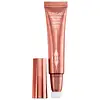What's inside
What's inside
 Key Ingredients
Key Ingredients

 Benefits
Benefits

 Concerns
Concerns

 Ingredients Side-by-side
Ingredients Side-by-side

Water
Skin ConditioningDimethicone
EmollientTrimethylsiloxyphenyl Dimethicone
Isotridecyl Isononanoate
EmollientButylene Glycol
HumectantMica
Cosmetic ColorantTin Oxide
AbrasiveTrimethylsiloxysilicate
EmollientGlycerin
HumectantPolymethylsilsesquioxane
Methyl Hydrogenated Rosinate
PerfumingSynthetic Fluorphlogopite
Cetyl PEG/PPG-10/1 Dimethicone
EmulsifyingPEG-10 Dimethicone
Skin ConditioningMagnesium Sulfate
Silica
AbrasiveMethicone
EmollientMagnesium Stearate
Cosmetic ColorantPhenoxyethanol
PreservativeEthylhexylglycerin
Skin ConditioningGlyceryl Behenate/Eicosadioate
EmollientDisodium EDTA
Titanium Dioxide
Cosmetic ColorantIron Oxides
Water, Dimethicone, Trimethylsiloxyphenyl Dimethicone, Isotridecyl Isononanoate, Butylene Glycol, Mica, Tin Oxide, Trimethylsiloxysilicate, Glycerin, Polymethylsilsesquioxane, Methyl Hydrogenated Rosinate, Synthetic Fluorphlogopite, Cetyl PEG/PPG-10/1 Dimethicone, PEG-10 Dimethicone, Magnesium Sulfate, Silica, Methicone, Magnesium Stearate, Phenoxyethanol, Ethylhexylglycerin, Glyceryl Behenate/Eicosadioate, Disodium EDTA, Titanium Dioxide, Iron Oxides
Water
Skin ConditioningHydrogenated Didecene
Skin ConditioningIsododecane
EmollientMica
Cosmetic ColorantGlycerin
HumectantPropanediol
SolventCetyl PEG/PPG-10/1 Dimethicone
EmulsifyingSilica
AbrasiveSodium Chloride
MaskingHydrogenated Styrene/Isoprene Copolymer
Hydroxyacetophenone
AntioxidantPolyglyceryl-4 Isostearate
Emulsifying1,2-Hexanediol
Skin ConditioningCaprylyl Glycol
EmollientTriethoxycaprylylsilane
Trisodium Ethylenediamine Disuccinate
Pentaerythrityl Tetra-Di-T-Butyl Hydroxyhydrocinnamate
AntioxidantLindera Strychnifolia Root Extract
Skin ConditioningPhenoxyethanol
PreservativeEthylhexylglycerin
Skin ConditioningCI 77891
Cosmetic ColorantCI 77491
Cosmetic ColorantCI 45405
Cosmetic ColorantWater, Hydrogenated Didecene, Isododecane, Mica, Glycerin, Propanediol, Cetyl PEG/PPG-10/1 Dimethicone, Silica, Sodium Chloride, Hydrogenated Styrene/Isoprene Copolymer, Hydroxyacetophenone, Polyglyceryl-4 Isostearate, 1,2-Hexanediol, Caprylyl Glycol, Triethoxycaprylylsilane, Trisodium Ethylenediamine Disuccinate, Pentaerythrityl Tetra-Di-T-Butyl Hydroxyhydrocinnamate, Lindera Strychnifolia Root Extract, Phenoxyethanol, Ethylhexylglycerin, CI 77891, CI 77491, CI 45405
 Reviews
Reviews

Ingredients Explained
These ingredients are found in both products.
Ingredients higher up in an ingredient list are typically present in a larger amount.
This ingredient is a high molecular weight silicone. It has emulsifying and skin conditioning properties.
Ethylhexylglycerin (we can't pronounce this either) is commonly used as a preservative and skin softener. It is derived from glyceryl.
You might see Ethylhexylglycerin often paired with other preservatives such as phenoxyethanol. Ethylhexylglycerin has been found to increase the effectiveness of these other preservatives.
Glycerin is already naturally found in your skin. It helps moisturize and protect your skin.
A study from 2016 found glycerin to be more effective as a humectant than AHAs and hyaluronic acid.
As a humectant, it helps the skin stay hydrated by pulling moisture to your skin. The low molecular weight of glycerin allows it to pull moisture into the deeper layers of your skin.
Hydrated skin improves your skin barrier; Your skin barrier helps protect against irritants and bacteria.
Glycerin has also been found to have antimicrobial and antiviral properties. Due to these properties, glycerin is often used in wound and burn treatments.
In cosmetics, glycerin is usually derived from plants such as soybean or palm. However, it can also be sourced from animals, such as tallow or animal fat.
This ingredient is organic, colorless, odorless, and non-toxic.
Glycerin is the name for this ingredient in American English. British English uses Glycerol/Glycerine.
Learn more about GlycerinMica is a naturally occurring mineral used to add shimmer and color in cosmetics. It can also help improve the texture of a product or give it an opaque, white/silver color.
Serecite is the name for very fine but ragged grains of mica.
This ingredient is often coated with metal oxides like titanium dioxide. Trace amounts of heavy metals may be found in mica, but these metals are not harmful in our personal products.
Mica has been used since prehistoric times throughout the world. Ancient Egyptian, Indian, Greek, Roman, Aztec, and Chinese civilizations have used mica.
Learn more about MicaPhenoxyethanol is a preservative that has germicide, antimicrobial, and aromatic properties. Studies show that phenoxyethanol can prevent microbial growth. By itself, it has a scent that is similar to that of a rose.
It's often used in formulations along with Caprylyl Glycol to preserve the shelf life of products.
Silica, also known as silicon dioxide, is a naturally occurring mineral. It is used as a fine, spherical, and porous powder in cosmetics.
Though it has exfoliant properties, the function of silica varies depending on the product.
The unique structure of silica enhances the spreadability and adds smoothness, making it a great texture enhancer.
It is also used as an active carrier, emulsifier, and mattifier due to its ability to absorb excess oil.
In some products, tiny microneedles called spicules are made from silica or hydrolyzed sponge. When you rub them in, they lightly polish away dead skin layers and enhance the penetration of active ingredients.
Learn more about SilicaWater. It's the most common cosmetic ingredient of all. You'll usually see it at the top of ingredient lists, meaning that it makes up the largest part of the product.
So why is it so popular? Water most often acts as a solvent - this means that it helps dissolve other ingredients into the formulation.
You'll also recognize water as that liquid we all need to stay alive. If you see this, drink a glass of water. Stay hydrated!
Learn more about Water